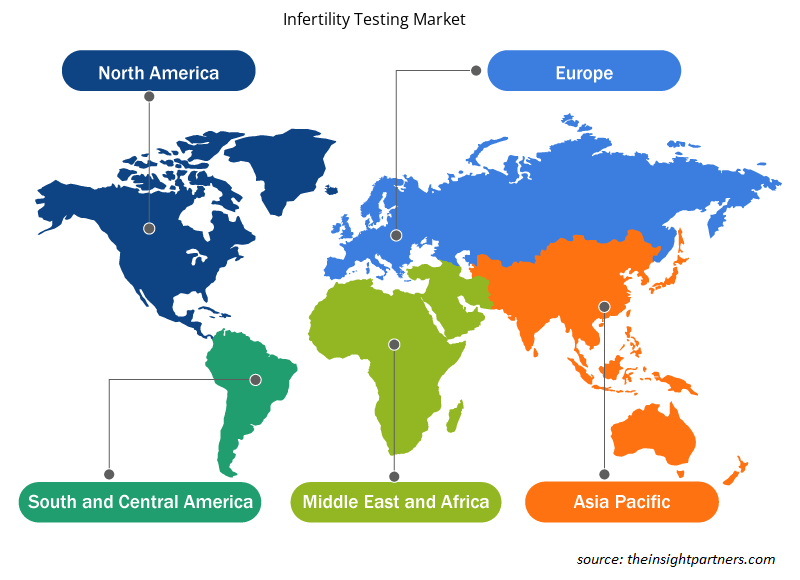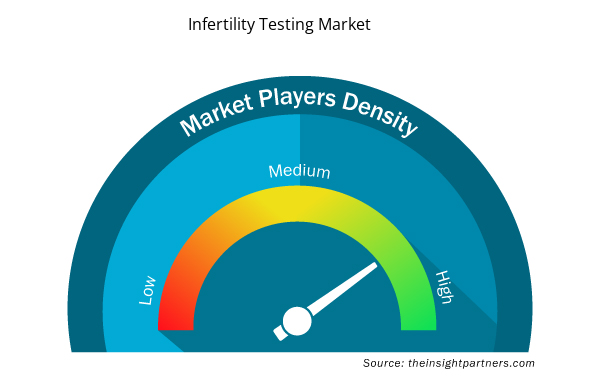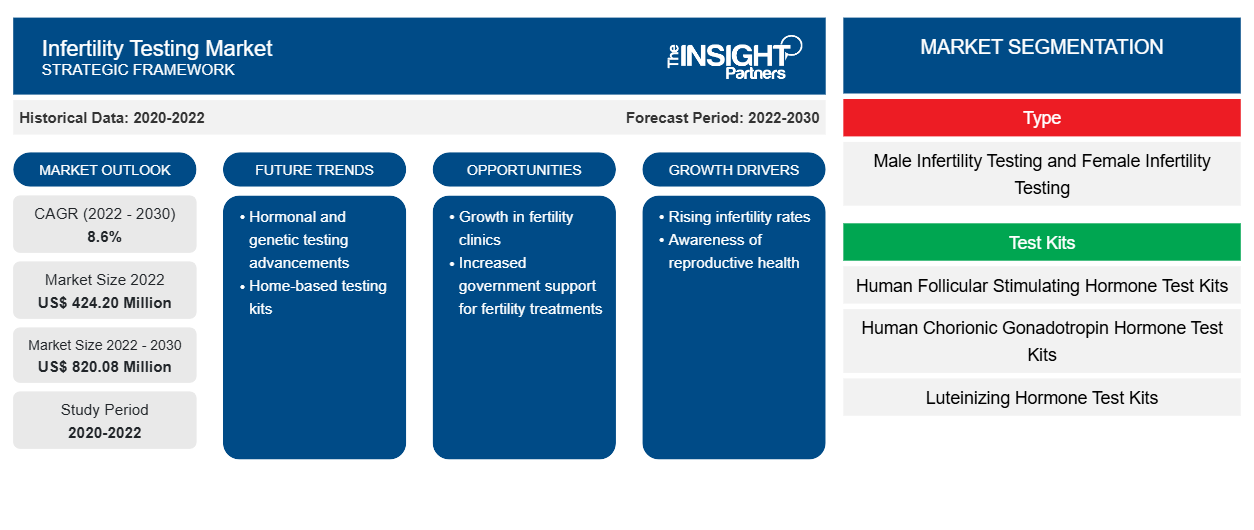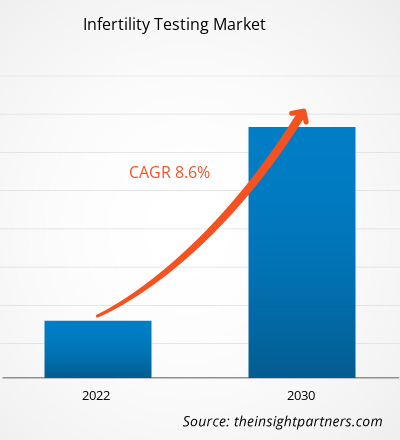[調査レポート] 不妊検査市場は、2022年の4億2,420万米ドルから2030年には8億2,008万米ドルに成長すると予測されており、2022年から2030年の間に市場は8.6%のCAGRを記録すると予測されています。
市場洞察とアナリストの見解:
男女の不妊症の増加や不妊検査の進歩などの要因が市場の成長を後押ししています。しかし、不妊検査キットに関する認識不足や限界が市場の成長を妨げています。
生殖能力の分野では、不妊症は個人の身体能力に影響を与えず、生命を脅かすこともない欠陥を指します。しかし、個人(男性と女性の両方)の発達に影響を与え、人格を弱め、欲求不満を引き起こす可能性があります。約5,000万〜8,000万のカップルが、生殖生活の中で少なくとも1回は不妊の問題を経験します。不妊の状況は、発展途上国と先進国では異なります。世界保健機関(WHO)によると、6組に1組のカップルが不妊の問題に悩まされています。検査に関する意識の高まりと、不健康な食生活の増加による不妊症や男女の婦人科疾患の傾向に伴うライフスタイルの変化は、不妊検査市場規模の拡大に貢献しています。さらに、排卵モニターの技術的進歩が市場の成長を牽引しています。喫煙とタバコの消費量の増加は不妊症例の増加につながり、不妊検査の需要を高めます。さらに、妊娠力に関する意識の高まり、PCOSの影響を受ける女性人口の増加、男女間の自己検査や遠隔モニタリング検査の需要の高まり、新製品の革新により、予測期間中に不妊検査市場にチャンスが生まれることが期待されます。
成長の原動力:
男女ともに不妊症の増加が不妊検査市場の成長を促進
男性不妊は世界的に蔓延している問題ですが、その割合は地域によって異なります。WHO によると、不妊カップルの約 20% は男性パートナーに問題があり、30% のカップルでは両方のパートナーに不妊の問題があります。男性不妊の一般的な原因は、下垂体で生成されるホルモンのレベルが低いこと、精液の欠乏と質、膣への精液の進入に影響を与える性的問題、および精子抗体の存在です。精子数が少ない最も一般的な原因は、精巣の静脈が拡張する静脈瘤です。米国保健福祉省によると、不妊の問題に苦しむ男性の約 40% に静脈瘤が見られます。精子数が少ないと男性不妊につながり、不妊検査市場が拡大しています。
晩婚化や加齢に伴う不妊の増加など、いくつかの要因により、世界中で出生率が着実に低下しています。WHOによると、2020年には世界中で成人(15〜49歳)のクラミジア感染症が新たに1億2,850万人発生したと推定されています。15〜49歳の人のクラミジア感染症の有病率は、女性で4.0%、男性で2.5%と推定されています。米国疾病管理予防センター(CDC)によると、米国では15〜44歳の女性の約10%(610万人)が妊娠または妊娠継続に問題を抱えています。したがって、出生率の低下により、男性と女性の不妊の原因を突き止めるための不妊検査の需要が高まり、不妊検査市場の成長を牽引しています。
要件に合わせてレポートをカスタマイズする
このレポートの一部、国レベルの分析、Excelデータパックなど、あらゆるレポートを無料でカスタマイズできます。また、スタートアップや大学向けのお得なオファーや割引もご利用いただけます。
- このレポートの主要な市場動向を入手してください。この無料サンプルには、市場動向から見積もりや予測に至るまでのデータ分析が含まれます。
レポートのセグメンテーションと範囲:
「不妊検査市場分析」は、タイプ、検査キット、サンプル、エンドユーザーというセグメントを考慮して実施されました。
セグメント分析:
不妊検査市場は、タイプ別に、男性不妊検査と女性不妊検査に分かれています。女性不妊検査セグメントは、2022年に大きな市場シェアを占めました。男性不妊検査セグメントは、予測期間中に9.2%という高いCAGRを記録すると予想されています。男性不妊の原因となる要因としては、ストレスレベルの増加、肥満、喫煙、アルコール摂取などが挙げられます。さらに、不妊に対する意識の高まり、研究開発費の増加、不妊検査市場の大手企業による製品発売の取り組み、ライフスタイルの変化などが、男性不妊検査分野の市場成長を後押ししています。
検査キット別に見ると、不妊検査市場は、ヒト卵胞刺激ホルモン (FSH) 検査キット、ヒト絨毛性ゴナドトロピン (HCG) ホルモン検査キット、黄体形成ホルモン (LH) 検査キット、その他に分類されます。ヒト卵胞刺激ホルモン(FSH)検査キットセグメントは、2022年に最大の市場シェアを占め、予測期間中に9.2%という最高のCAGRを記録すると予想されています。 卵胞刺激ホルモン(FSH)検査キットは、血液中に存在するFSHホルモンの濃度を測定するのに役立ちます。 この検査は、不妊症、更年期障害、性的発達の問題など、さまざまな理由で男性と女性のFSHレベルを評価するためによく使用されます。 FSHは、女性の月経周期と卵巣内の卵子を含む卵胞の成長を制御するのに役立ちます。 男性では、FSHは精子の生成と輸送を調節します。 この検査は、精子数を決定するために使用されます。 したがって、FSH検査キットは、生殖の問題やホルモンの不均衡に関連するその他の状態を評価するための重要な診断ツールです。さらに、先進的なバイオシミラー FSH 製品、規制当局の承認、市場へのアクセス、FSH キット製造における技術的進歩、効果的な避妊オプションに対するニーズの高まりにより、世界市場の成長が加速すると予測されています。
サンプル別に見ると、不妊検査市場は血液、尿、その他に分類されます。血液セグメントは2022年に最大の市場シェアを占めました。同じセグメントは、予測期間中に9.1%という最高のCAGRを記録すると予想されています。不妊検査は通常、重要なホルモンを測定するための血液検査です。カップルの状況に応じて、女性または男性は異なる血液検査を必要とする場合があります。必要な血液検査には、卵胞刺激ホルモン(FSH)、抗ミュラー管ホルモン(AMH)、黄体形成ホルモン(LH)などがあります。2021年1月、健康系スタートアップのYesmomは、女性が自宅で快適に生殖に関する健康を優先できるように、アジア初の在宅女性不妊血液検査キットを発売しました。
不妊検査市場は、エンドユーザー別に、病院・クリニック、不妊治療センター、在宅ケアに分類されます。在宅ケア部門は2022年に最大の市場シェアを占め、予測期間中に9.0%という最高のCAGRを記録すると予想されています。この部門は、健康状態の自己監視に対する患者の好み、電子商取引ウェブサイトでの不妊検査キットへの容易なアクセス、ユーザーフレンドリーで使いやすいデバイスの可用性、検査結果の機密性に対する好みの高まりにより、成長すると予想されます。
生殖補助医療(ART)と体外受精(IVF)の導入により不妊検査市場が加速
不妊症に対する意識の高まりにより、今後数年間で体外受精と生殖補助医療の需要が促進されると予想されます。細胞質内精子注入法の高度な治療法の導入と体外受精治療の薬物療法および外科的処置に対する意識の高まりにより、予測期間中に不妊症検査市場が成長すると予想されます。UCSF Health によると、不妊症の約 10% は原因不明であり、残りの 30% は男性と女性のパートナーの問題によるものです。
男性に行われる一般的な処置には、卵細胞質内精子注入法 (ICSI)、精巣上体吸引法、精管吸引法、精巣精子抽出法、不合格検査のマッピングなどがあります。男性因子を持つ男性の約 75% は、生殖能力に影響を与える特定可能または治療可能な症状を抱えています。さらに、男性因子不妊症の男性のほぼ全員が、通常 ART で治療可能です。したがって、ART と IVF の採用が拡大することで、今後数年間で不妊検査市場に新たなトレンドが生まれる可能性があります。
地域分析:
不妊検査市場レポートの範囲には、北米、ヨーロッパ、アジア太平洋、南米および中米、中東およびアフリカが含まれます。
2022年、北米は不妊検査の市場シェアで最大でした。この地域の市場成長は、不妊症の発生率の高さ、男女間での不妊検査に対する意識の高まり、女性の初産年齢の上昇、電子商取引ウェブサイトを通じた不妊検査キットの容易な入手性によって推進されています。さらに、喫煙とタバコ消費の普及率の上昇は不妊症の症例の増加につながり、市場の成長を後押しします。検査に対する意識の高まりとPCOSの影響を受ける女性人口の増加も市場の成長を加速させています。
ヨーロッパの不妊検査市場は、世界市場で3番目に大きなシェアを占めると予想されています。ヨーロッパ市場の成長は、不妊問題、糖尿病人口、この地域での多数のプレーヤーの存在、および不妊に関連する政府の取り組みに関する意識の高まりによって推進されています。欧州人類生殖発生学会によると、不妊症は2021年にヨーロッパ全土で2,500万人以上に影響を与えると推定されています。ヨーロッパでは、小学校クラスごとに1人の子供が生殖補助技術(ART)を使用して生まれており、北欧諸国では出生の2〜7%がARTによるものです。スペインは、他のEU諸国と比較して進歩的な法的枠組み、高いレベルの不妊専門家、優れた施設、高度な医療技術を備えているため、不妊治療の好ましい目的地国の1つです。Fertility Europe(FE)は、20を超えるヨーロッパ諸国の不妊問題に携わるヨーロッパの協会の統括組織です。これらの団体は、不妊症に悩む人々の権利を向上させ、ベストプラクティスを実現・共有するために欧州の患者の間で強力な国境を越えたネットワークを構築し、不妊症に関する社会の認識を高め、生殖保健の保護の分野での教育を推進することを目指しています。
アジア太平洋地域の不妊検査市場は、予測期間中に9.1%という最も高い成長率を記録すると予想されています。この地域の市場成長は、生活習慣病に悩む女性の数の増加、不妊検査製品の開発への資金/投資の増加、およびアジア太平洋地域の不妊検査市場に対する国内外の企業の注目度の高まりに起因しています。
不妊検査市場の地域別分析
予測期間を通じて不妊検査市場に影響を与える地域的な傾向と要因は、Insight Partners のアナリストによって徹底的に説明されています。このセクションでは、北米、ヨーロッパ、アジア太平洋、中東およびアフリカ、南米および中米にわたる不妊検査市場のセグメントと地理についても説明します。

- 不妊検査市場の地域別データを入手
不妊検査市場レポートの範囲
| レポート属性 | 詳細 |
|---|---|
| 2022年の市場規模 | 4億2,420万米ドル |
| 2030年までの市場規模 | 8億2,008万米ドル |
| 世界のCAGR(2022年 - 2030年) | 8.6% |
| 履歴データ | 2020-2022 |
| 予測期間 | 2022-2030 |
| 対象セグメント | タイプ別
|
| 対象地域と国 | 北米
|
| 市場リーダーと主要企業プロフィール |
|
不妊検査市場のプレーヤー密度:ビジネスダイナミクスへの影響を理解する
不妊検査市場は、消費者の嗜好の変化、技術の進歩、製品の利点に対する認識の高まりなどの要因により、エンドユーザーの需要が高まり、急速に成長しています。需要が高まるにつれて、企業は提供内容を拡大し、消費者のニーズを満たすために革新し、新たなトレンドを活用し、市場の成長をさらに促進しています。
市場プレーヤー密度とは、特定の市場または業界内で活動している企業または会社の分布を指します。これは、特定の市場スペースに、その市場規模または総市場価値に対してどれだけの競合相手 (市場プレーヤー) が存在するかを示します。
不妊検査市場で事業を展開している主要企業は次のとおりです。
- メルク
- プロクター・アンド・ギャンブル
- ビオメリューSA
- アレア株式会社
- ベビースタート株式会社
免責事項:上記の企業は、特定の順序でランク付けされていません。

- 不妊検査市場のトップキープレーヤーの概要を入手
業界の発展と将来の機会:
不妊検査市場の予測は、この市場の関係者が成長戦略を計画するのに役立ちます。市場で活動している大手企業のプレスリリースによると、いくつかの戦略的展開が以下にリストされています。
- 2023 年 7 月、自己診断テストの世界的リーダーとして尊敬されている 2San は Proov と提携し、中西部の 8 つの州にある厳選された Hy-Vee 店舗で、独占的で使いやすい在宅不妊検査を開始しました。
- 不妊治療と家族形成ケアの大手プロバイダーである Kindbody は、生殖の過程を通じて人々をサポートすることに特化した消費者向け製品部門である Kind at Home を 2022 年 1 月に立ち上げました。この取り組みは、女性と男性向けの使いやすい家庭用生殖ホルモン検査の導入から始まりました。
- 2021 年 12 月、Carrot Fertility は、人々が自宅で生殖ホルモンや関連バイオマーカーをモニタリングできるようにする新しいキットの発売を発表しました。カスタマイズされた検査キットにより、生殖の健康状態をより包括的に把握でき、自宅で快適に早期の行動や介入が可能になります。
競争環境と主要企業:
Merck KgaA、Procter & Gamble、bioMerieux SA、Alere Inc.、Babystart Ltd.、bioZhena Corporation、Quidel Corporation、CENTOGENE NV、SCSA Diagnostics, Inc.、およびBoditech Med Inc.は、不妊検査市場レポートで紹介されている著名な企業の一部です。これらの企業は、新しい技術の開発、既存製品のアップグレード、および世界中で高まる消費者の需要を満たすための地理的プレゼンスの拡大に重点を置いています。
- 過去2年間の分析、基準年、CAGRによる予測(7年間)
- PEST分析とSWOT分析
- 市場規模価値/数量 - 世界、地域、国
- 業界と競争環境
- Excel データセット


- Adaptive Traffic Control System Market
- Energy Recovery Ventilator Market
- Semiconductor Metrology and Inspection Market
- Small Internal Combustion Engine Market
- Europe Surety Market
- Machine Condition Monitoring Market
- Electronic Toll Collection System Market
- Trade Promotion Management Software Market
- Constipation Treatment Market
- Artificial Intelligence in Defense Market

Report Coverage
Revenue forecast, Company Analysis, Industry landscape, Growth factors, and Trends

Segment Covered
This text is related
to segments covered.

Regional Scope
North America, Europe, Asia Pacific, Middle East & Africa, South & Central America

Country Scope
This text is related
to country scope.
よくある質問
The global infertility testing market, based on type, the infertility testing market analysis is carried out by considering the following segments: male infertility testing and female infertility testing. The female infertility testing segment held a larger market share in 2022. The male infertility testing segment is anticipated to register a higher CAGR of 9.2% during the forecast period. By test kits, the infertility testing market is segmented into human follicular stimulating hormone (FSH) test kits, human chorionic gonadotropin (HCG) hormone test kits, luteinizing hormone (LH) test kits, and others. In terms of revenue, the human follicular stimulating hormone (FSH) test kits segment dominated the infertility testing market share in 2022. The same is anticipated to register the highest CAGR of 9.2% during the forecast period. The infertility testing market, based on sample, is segmented into blood, urine, and others. The blood segment held the largest market share in 2022 and is anticipated to register the highest CAGR of 9.1% during the forecast period. The infertility testing market, by end user, is categorized into hospitals & clinics, fertility centers, and homecare. The homecare segment held the largest market share in 2022 and is anticipated to register the highest CAGR of 9.0% during the forecast period.
The infertility testing market is expected to be valued at US$ 820.08 million in 2030.
Infertility is defined as the failure to attain a clinical pregnancy after a minimum duration of one year of regular and timely attempts, which was later known to include physiological or psychological conditions that were inconsistent with the natural encounter of the gametes. Rising awareness about testing, technological advancements in ovulation monitors, and changing lifestyles with increasing trends of unhealthy diets leading to infertility and gynecological disorders in men and women are among the significant factors responsible for the infertility testing market growth.
The factors driving the growth of the infertility testing market include the increasing cases of infertility in men and women and growing advancements in infertility testing.
The infertility testing market majorly consists of the players such as Merck KgaA; Procter & Gamble; bioMerieux SA; Alere Inc.; Babystart Ltd.; bioZhena Corporation; Quidel Corporation; CENTOGENE N.V.; SCSA Diagnostics, Inc.; and Boditech Med Inc.
The infertility testing market was valued at US$ 424.20 million in 2022.
Trends and growth analysis reports related to Life Sciences : READ MORE..
The List of Companies - Infertility Testing Market
- Merck KgaA
- Procter & Gamble
- bioMerieux SA
- Alere Inc.
- Babystart Ltd.
- bioZhena Corporation
- Quidel Corporation
- CENTOGENE N.V
- SCSA Diagnostics, Inc.
- Boditech Med Inc.
The Insight Partners performs research in 4 major stages: Data Collection & Secondary Research, Primary Research, Data Analysis and Data Triangulation & Final Review.
- Data Collection and Secondary Research:
As a market research and consulting firm operating from a decade, we have published and advised several client across the globe. First step for any study will start with an assessment of currently available data and insights from existing reports. Further, historical and current market information is collected from Investor Presentations, Annual Reports, SEC Filings, etc., and other information related to company’s performance and market positioning are gathered from Paid Databases (Factiva, Hoovers, and Reuters) and various other publications available in public domain.
Several associations trade associates, technical forums, institutes, societies and organization are accessed to gain technical as well as market related insights through their publications such as research papers, blogs and press releases related to the studies are referred to get cues about the market. Further, white papers, journals, magazines, and other news articles published in last 3 years are scrutinized and analyzed to understand the current market trends.
- Primary Research:
The primarily interview analysis comprise of data obtained from industry participants interview and answers to survey questions gathered by in-house primary team.
For primary research, interviews are conducted with industry experts/CEOs/Marketing Managers/VPs/Subject Matter Experts from both demand and supply side to get a 360-degree view of the market. The primary team conducts several interviews based on the complexity of the markets to understand the various market trends and dynamics which makes research more credible and precise.
A typical research interview fulfils the following functions:
- Provides first-hand information on the market size, market trends, growth trends, competitive landscape, and outlook
- Validates and strengthens in-house secondary research findings
- Develops the analysis team’s expertise and market understanding
Primary research involves email interactions and telephone interviews for each market, category, segment, and sub-segment across geographies. The participants who typically take part in such a process include, but are not limited to:
- Industry participants: VPs, business development managers, market intelligence managers and national sales managers
- Outside experts: Valuation experts, research analysts and key opinion leaders specializing in the electronics and semiconductor industry.
Below is the breakup of our primary respondents by company, designation, and region:

Once we receive the confirmation from primary research sources or primary respondents, we finalize the base year market estimation and forecast the data as per the macroeconomic and microeconomic factors assessed during data collection.
- Data Analysis:
Once data is validated through both secondary as well as primary respondents, we finalize the market estimations by hypothesis formulation and factor analysis at regional and country level.
- Macro-Economic Factor Analysis:
We analyse macroeconomic indicators such the gross domestic product (GDP), increase in the demand for goods and services across industries, technological advancement, regional economic growth, governmental policies, the influence of COVID-19, PEST analysis, and other aspects. This analysis aids in setting benchmarks for various nations/regions and approximating market splits. Additionally, the general trend of the aforementioned components aid in determining the market's development possibilities.
- Country Level Data:
Various factors that are especially aligned to the country are taken into account to determine the market size for a certain area and country, including the presence of vendors, such as headquarters and offices, the country's GDP, demand patterns, and industry growth. To comprehend the market dynamics for the nation, a number of growth variables, inhibitors, application areas, and current market trends are researched. The aforementioned elements aid in determining the country's overall market's growth potential.
- Company Profile:
The “Table of Contents” is formulated by listing and analyzing more than 25 - 30 companies operating in the market ecosystem across geographies. However, we profile only 10 companies as a standard practice in our syndicate reports. These 10 companies comprise leading, emerging, and regional players. Nonetheless, our analysis is not restricted to the 10 listed companies, we also analyze other companies present in the market to develop a holistic view and understand the prevailing trends. The “Company Profiles” section in the report covers key facts, business description, products & services, financial information, SWOT analysis, and key developments. The financial information presented is extracted from the annual reports and official documents of the publicly listed companies. Upon collecting the information for the sections of respective companies, we verify them via various primary sources and then compile the data in respective company profiles. The company level information helps us in deriving the base number as well as in forecasting the market size.
- Developing Base Number:
Aggregation of sales statistics (2020-2022) and macro-economic factor, and other secondary and primary research insights are utilized to arrive at base number and related market shares for 2022. The data gaps are identified in this step and relevant market data is analyzed, collected from paid primary interviews or databases. On finalizing the base year market size, forecasts are developed on the basis of macro-economic, industry and market growth factors and company level analysis.
- Data Triangulation and Final Review:
The market findings and base year market size calculations are validated from supply as well as demand side. Demand side validations are based on macro-economic factor analysis and benchmarks for respective regions and countries. In case of supply side validations, revenues of major companies are estimated (in case not available) based on industry benchmark, approximate number of employees, product portfolio, and primary interviews revenues are gathered. Further revenue from target product/service segment is assessed to avoid overshooting of market statistics. In case of heavy deviations between supply and demand side values, all thes steps are repeated to achieve synchronization.
We follow an iterative model, wherein we share our research findings with Subject Matter Experts (SME’s) and Key Opinion Leaders (KOLs) until consensus view of the market is not formulated – this model negates any drastic deviation in the opinions of experts. Only validated and universally acceptable research findings are quoted in our reports.
We have important check points that we use to validate our research findings – which we call – data triangulation, where we validate the information, we generate from secondary sources with primary interviews and then we re-validate with our internal data bases and Subject matter experts. This comprehensive model enables us to deliver high quality, reliable data in shortest possible time.


 このレポートの無料サンプルを入手する
このレポートの無料サンプルを入手する